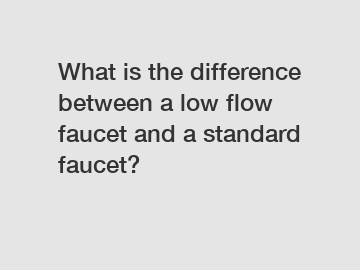What is the difference between a low flow faucet and a standard faucet?
Water is a precious resource, and as awareness of sustainability grows, so does the need to minimize wastage. One area where small changes can lead to significant water savings is in our everyday faucets. In this blog, we explore the difference between low flow faucets and standard faucets, shedding light on their unique features as well as the benefits they offer. Let's dive in!
Understanding Low Flow Faucets:
Low flow faucets, as the name suggests, are designed to limit water flow while maintaining optimal functionality. These innovative fixtures are engineered to deliver a reduced water flow rate compared to standard faucets. The reduced water flow helps to conserve water, ultimately benefiting both the environment and your household's water bills.

Key Features of Low Flow Faucets:
1. Water-saving aerators: Low flow faucets often utilize aerators, which mix air with water to reduce water flow while maintaining sufficient pressure. These aerators help achieve a balanced, steady stream of water, making low flow faucets just as effective in everyday use as standard faucets.
2. Flow restrictors: Another essential feature in low flow faucets is the implementation of flow restrictors. These devices can be integrated internally or externally in the faucet. Flow restrictors limit the maximum flow rate, allowing you to control the amount of water released with each use.
3. Adjustable settings: Some low flow faucets offer adjustable settings, allowing users to customize the water flow rate according to their specific needs. This flexibility is particularly beneficial when engaging in tasks that require varying amounts of water, such as filling a pot or rinsing delicate items.
Advantages of Low Flow Faucets:
1. Water conservation: The most significant benefit of low flow faucets is their ability to conserve water. With a reduced flow rate, these fixtures can cut water usage by up to 60% compared to standard faucets. This is especially crucial in areas where water scarcity is a pressing concern or during drought seasons.
2. Energy savings: By reducing the volume of water used, low flow faucets indirectly save energy. Less hot water consumption not only lowers your utility bills but also reduces the demand on your water heater. Consequently, this leads to a longer lifespan for your water heater and a reduced environmental impact.
3. Cost-effective: Installing low flow faucets is an investment that pays off over time. Although they may cost slightly more upfront, the savings on your water bills and potential energy bills make them a financially-wise long-term choice.
Exploring Standard Faucets:
Standard faucets, or traditional faucets, work by providing a constant flow of water without any means of regulating it. While they have been the standard choice for decades, their water efficiency pales in comparison to low flow faucets.
The Downside of Standard Faucets:
1. Wasted water: Standard faucets can be notorious for excessive water usage. They typically have a flow rate of around 2.2 gallons per minute (GPM) or more. Considering that the average person spends approximately four minutes each day using a faucet, the cumulative wastage can be significant over time.
2. Environmental impact: The excessive water usage associated with standard faucets not only strains water supplies but also adds unnecessary stress to local ecosystems. Water treatment and purification processes incur additional environmental costs due to higher water demand.
Choosing the Right Faucet for Your Needs:
When it comes to selecting between a low flow faucet and a standard faucet, the choice becomes clear. Low flow faucets provide an eco-friendly and cost-effective solution without compromising functionality. The initial investment in a low flow faucet will significantly reduce water consumption, conserve energy resources, and contribute positively to the environment.
In Conclusion:
The benefits of low flow faucets are undeniable. With their ability to conserve water, save energy, and optimize functionality, these fixtures are the way forward in sustainable living. By replacing standard faucets with low flow alternatives, we can all play an active role in preserving our planet's most precious resource. Let's make the switch today and embrace the power of small changes for a better future!
If you want to learn more, please visit our website wholesale professional kitchen faucet, wholesale commercial faucets, wholesale commercial kitchen faucets.
173
0
0

Comments
All Comments (0)